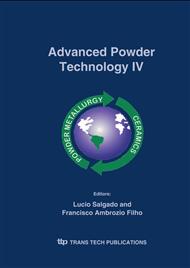p.407
p.413
p.420
p.425
p.430
p.436
p.442
p.447
p.453
Using Experiments Design to Model Linear Firing Shrinkage of Triaxial Ceramic Bodies
Abstract:
In the development and manufacture stages of floor and wall ceramic tiles, firing shrinkage is basically determined by the combination of raw materials and frequently used as quality control parameters. This configures the ideal scenario to apply the techniques of experiments design, often used in various other areas, to model those properties of such ceramics bodies. In this work, ten formulations of three different raw materials, namely a clay mixture, potash feldspar and quartz (triaxial compositions) were selected and processed under conditions similar to those used in the ceramics industry. With the experimental results, a regression model was calculated, relating linear shrinkage with composition. After statistical analysis and verification experiments, the significance and validity of the model was confirmed. The regression model can then be used to select the best combination of those three raw materials to produce a ceramic body with specified properties.
Info:
Periodical:
Pages:
430-435
Citation:
Online since:
November 2005
Price:
Сopyright:
© 2005 Trans Tech Publications Ltd. All Rights Reserved
Share:
Citation:


